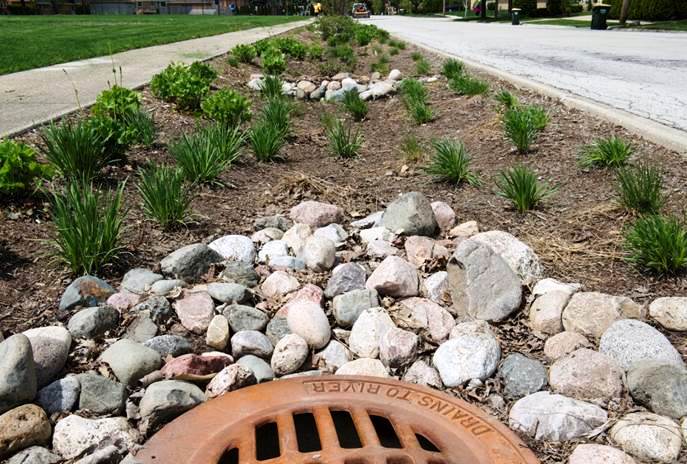On June 18, 2019 the Metropolitan Water Reclamation District of Greater Chicago (MWRD) announced that it was now offering local government partners green infrastructure project assistance. While that assistance itself is only available in the greater Chicago, Illinois area, we’re featuring it here in REVITALIZATION because it’s an example of the kind of program metropolitan water agencies worldwide should be offering.
Green infrastructure captures water and allows it to infiltrate into the ground before it enters the traditional conveyance system. This helps to reduce the amount of water flowing through pipes that can be overwhelmed by intense rain events.
“After the wettest May in Chicago history, now is an ideal time to collaborate on green infrastructure projects that work to enhance community spaces and mitigate flooding,” said MWRD President Kari K. Steele. “We want communities to share their ideas about how green infrastructure can help mitigate flooding on a local level. These green infrastructure projects allow us to work together with communities to implement sustainable storm water management options that benefit the environment.”
“We are experiencing record spring rain totals for the second consecutive year and have to be proactive in managing our stormwater,” said MWRD Vice President Barbara McGowan. “Now is the time to hear from our community partners on how we can best leverage our resources to address flooding through green infrastructure. We look forward to strengthening these partnerships.”
The MWRD is the regional stormwater authority for Cook County and holds an annual call for green infrastructure projects from throughout its service area. Recent projects chosen for funding and assistance by the MWRD have included permeable parking lots, rain gardens, bioswales and green alleys.
Conventional gray infrastructure enlists concrete pipes to convey stormwater. On the other hand, green infrastructure mimics the natural environment by collecting precipitation where it falls by detaining and infiltrating runoff through rain gardens, permeable pavement, cisterns and other practices.
Green infrastructure’s impact is not limited to flooding concerns. It can reduce wet-weather flows to combined sewer systems, reduce combined sewer overflows to local waterways and protect water quality in these vital waterways. Green infrastructure also reduces runoff volumes and improves water quality in separate sewer service areas. In addition, green infrastructure provides social benefits that enhance the livability of communities.
The MWRD intends to provide partial funding towards the construction of selected green infrastructure installations on public property. Project partners will be expected to provide long-term operation and maintenance of the installed green infrastructure practices, among other responsibilities to be defined through intergovernmental agreements with the MWRD and the selected applicant partners.
The MWRD will prioritize the submitted projects based on the project’s stormwater benefits, such as reduction of basement flooding, the capability of the applicant to operate and maintain the green infrastructure practices, and the visibility of the project in terms of providing educational opportunities amongst other factors.
“This is a terrific time to invest in green infrastructure projects that work to enhance community spaces and mitigate flooding, but we want to hear directly from those communities on the ground level to learn how we can work together and best address stormwater management concerns,” said MWRD Commissioner Kimberly DuBuclet, chairman of the MWRD Stormwater Committee. “Green infrastructure allows us to make that difference and benefits the environment.”
Public agencies within the MWRD’s corporate boundaries are encouraged to submit an application online by visiting www.mwrd.org. Eligibility requirements and instructions are included in the application form which can be found at www.mwrd.org/irj/portal/anonymous/GI
If you happen to be in Cook County, Illinois, MWRD is accepting applications from municipal, township and county agencies within Cook County to fund projects that use green infrastructure until August 9, 2019.
Featured photo (courtesy of MWRD) shows a bioswale and 1070-square-yard permeable pavement parking lot in Niles. The project reduces localized flooding, reduces the flow of stormwater into the local combined sewer system. MWRD contributed funds towards it.

